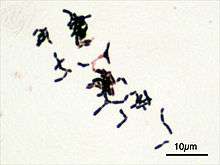Bifidobacteriales
Bifidobacteriales is an order of bacteria,[1] in the subclass of Actinobacteridae.
| Bifidobacteriales | |
|---|---|
 | |
| Bifidobacterium adolescentis | |
| Scientific classification | |
| Domain: | Bacteria |
| Phylum: | Actinobacteria |
| Class: | Actinobacteria |
| Order: | Bifidobacteriales Stackebrandt et al. 1997 emend. Zhi et al. 2009 |
Family and genera
- Bifidobacteriaceae
- Aeriscardovia
- Alloscardovia
- Bifidobacterium
- Bombiscardovia
- Galliscardovia
- Gardnerella
- Neoscardovia
- Parascardovia
- Pseudoscardovia
- Scardovia
- incertae sedis
Genomics
In a phylogenetic tree for the order Bifidobacteriales, based on RpoB, RpoC, and DNA Gyrase B, Gardnerella vaginalis branches between different Bifidobacterium species, which makes the genus Bifidobacterium polyphyletic. The genus could be made monophyletic if G. vaginalis was placed within Bifidobacterium. Comparative analysis of aligned protein sequences has led to the discovery of two conserved signature indels which are specific for the order Bifidobacteriales. The first indel, a 1 amino acid deletion in ribosomal protein L13, is found in all Bifidobacteriales species and no other Actinobacteria, providing a potential molecular marker for the entire Bifidobacteriales order. The second indel that has been identified is a 1 amino acid insertion in glucose-6-phosphate dehydrogenase found in all Bifidobacterium species and G. vaginalis, but not in any other Actinobacteria. This indel is thus characteristic of the clade consisting of Bifidobacterium species and G. vaginalis and can be used to distinguish these genera from the rest of the order Bifidobacteriales. 16 conserved signature proteins have also been identified which are unique to the order Bifidobacteriales and can be used as molecular markers for this order. Additionally, 6 conserved signature proteins which are unique to Bifidobacterium and Gardnerella have been identified, providing further evidence that species from these two genera are closely related and providing molecular markers for the clade consisting of these genera.[2]
References
- Krogius-Kurikka L, Kassinen A, Paulin L, et al. (2009). "Sequence analysis of percent G+C fraction libraries of human faecal bacterial DNA reveals a high number of Actinobacteria". BMC Microbiol. 9: 68. doi:10.1186/1471-2180-9-68. PMC 2679024. PMID 19351420.
- Gao, B.; Gupta, R. S. (2012). "Phylogenetic Framework and Molecular Signatures for the Main Clades of the Phylum Actinobacteria". Microbiology and Molecular Biology Reviews. 76 (1): 66–112. doi:10.1128/MMBR.05011-11. PMC 3294427. PMID 22390973.